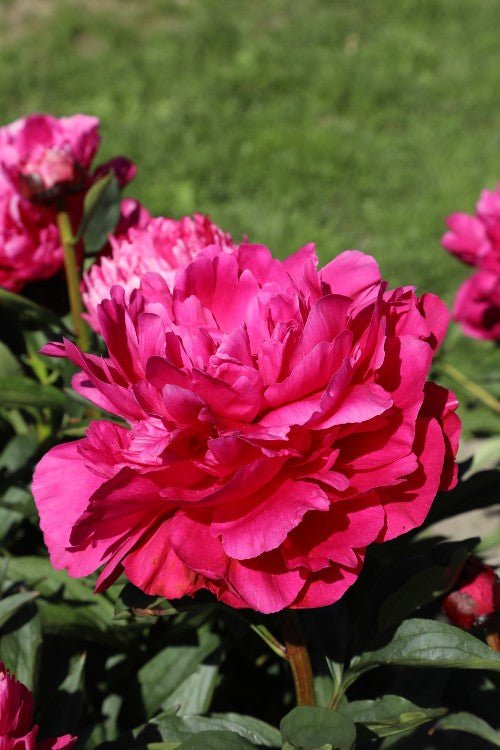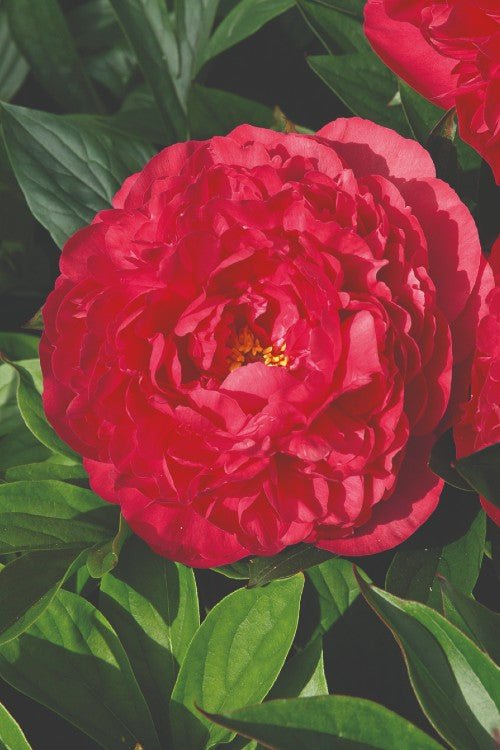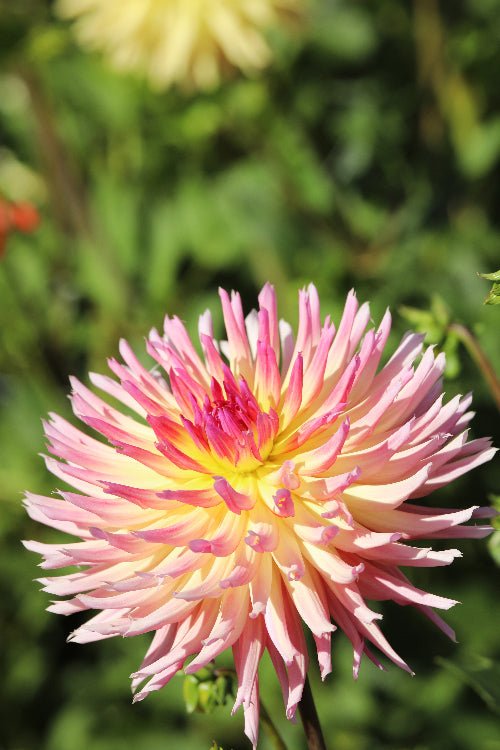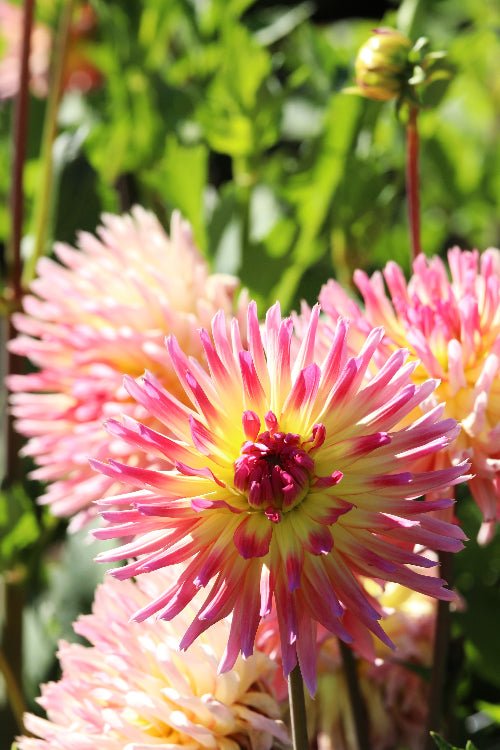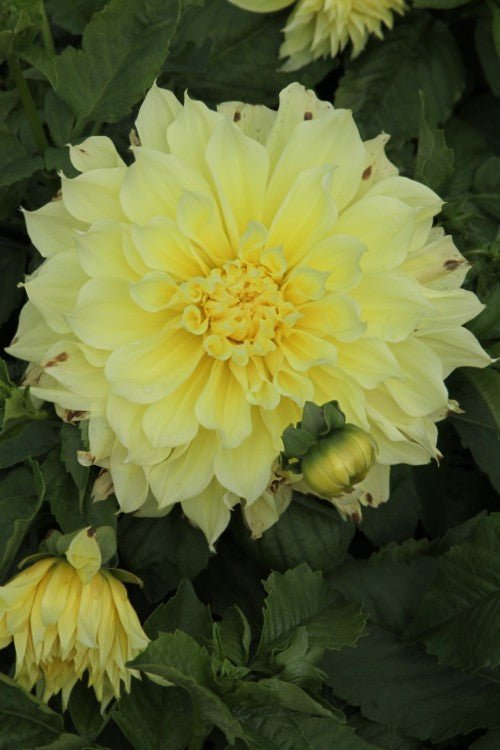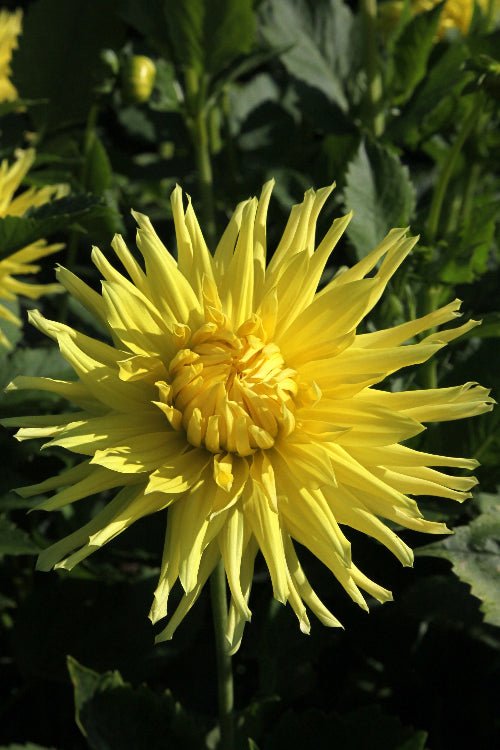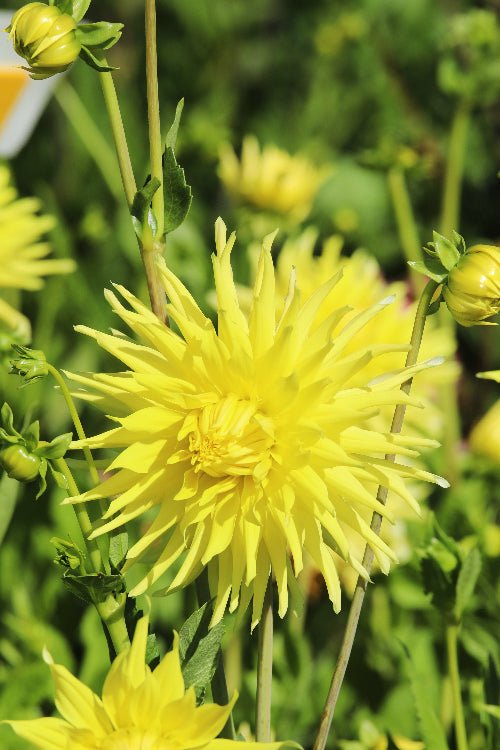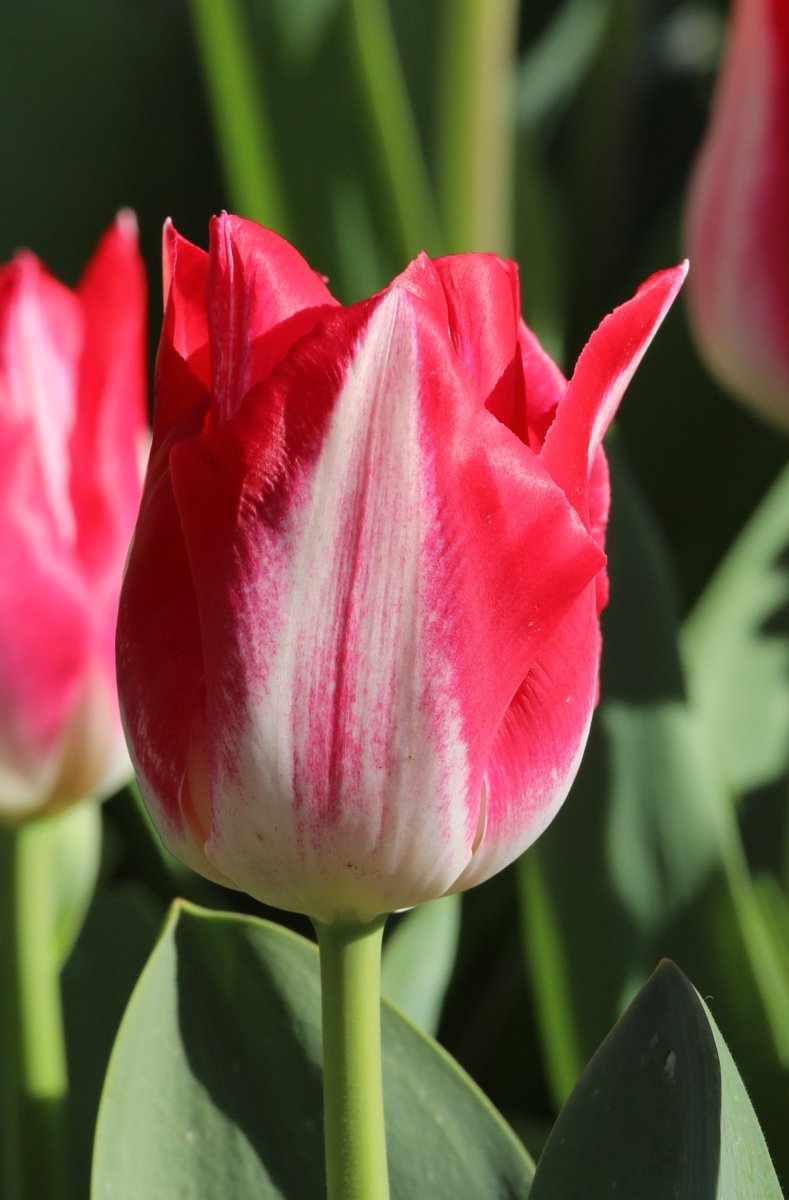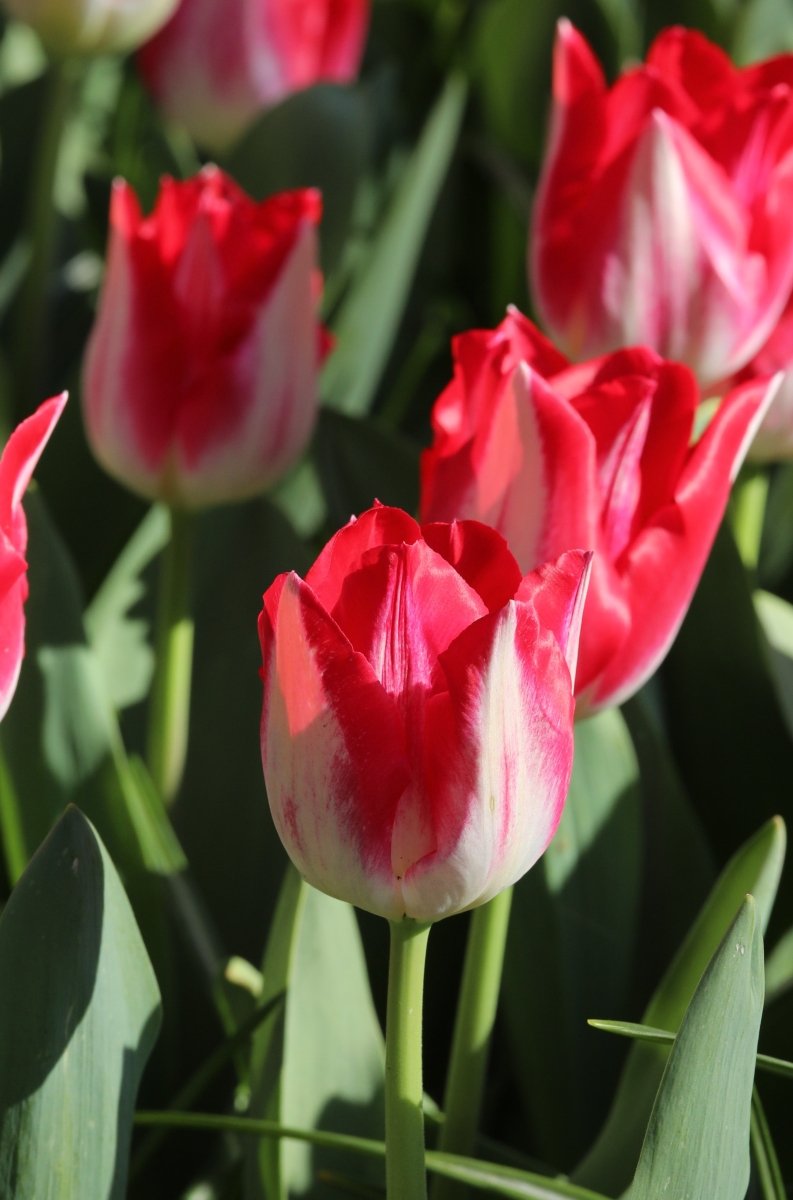Sort by:
Get ready to transport your garden back to the prehistoric era with the Jurassic Park Bearded Iris. This Jurassic-themed flower is sure to be a hit with dino-loving gardeners and paleontologists alike!
With its bright purple and yellow petals, this flower is reminiscent of the fiery lava flows that once covered the earth. And let's not forget about the striking purple "beard", which is sure to attract the attention of even the most ferocious of T-Rexes.
But don't worry, this plant won't come to life and start chasing you around your garden - it's just a harmless and beautiful flower. In fact, the Jurassic Park Bearded Iris is incredibly easy to care for and will thrive in most garden environments. And who knows, maybe it'll even attract some friendly herbivores to your yard!
So why not add a touch of prehistoric charm to your garden with the Jurassic Park Bearded Iris? Just be sure to keep an eye out for any roaming Velociraptors...
About Kansas
Peony Kansas is the perfect addition to any garden. With its delicate pink blooms and lush green foliage, it's sure to add a touch of elegance to any outdoor space.
- These beautiful flowers bloom in late spring, adding color and beauty to your garden just in time for summer.
- Peony Kansas is a hardy plant that can withstand harsh weather conditions and pests.
- The plant will grow up to 3 feet tall and 2 feet wide, making it perfect for any size garden
How to care for Kansas
- Choose a spot in your garden that gets at least 6 hours of direct sunlight per day.
- Prepare the soil by digging a hole about 2-3 inches deep and adding compost or organic matter to the soil.
- Plant the Peony Kansas bulb with the pointed side up and cover it with soil.
- Water the plant well and add mulch to keep the soil moist.
- Fertilize the plant with a balanced fertilizer once a month during the growing season.
- Deadhead the flowers as they fade to encourage more blooms.
- Cut the leaves back in the fall to prevent disease.
About Kansas Proud
The Single Late Tulip Kansas Proud is a stunning addition to any garden. Its burgundy red petals create a beautiful contrast, making it the perfect choice for adding a burst of color in your landscape. This tulip variety blooms later in the season, ensuring your garden remains vibrant long after other flowers have faded.
-
Vibrant color: burgundy-red petals
-
Late bloomer: enjoy a long-lasting display as it blooms in late spring.
-
Sturdy and tall: reaches impressive heights, creating a dramatic focal point.
-
Easy to grow: perfect for both beginners and experienced gardeners.
-
Versatile planting: ideal for flower beds, borders, and containers.
How to plant and take care of Single Late Tulip Kansas Proud:
-
Planting depth: place bulbs 6-8 inches deep in well-drained soil.
-
Spacing: space the bulbs 4-6 inches apart to allow room for growth.
-
Sunlight: choose a location with full sun or light shade for best results.
-
Watering: water the tulips regularly, but avoid overwatering to prevent bulb rot.
-
Fertilizing: use a balanced fertilizer in early spring to encourage healthy blooms.
-
Post-bloom care: once the flowers have faded, cut back the stems but leave the leaves to die naturally. This helps nourish the bulb for the next season
About karataviense
Allium karataviense is a compact and eye-catching ornamental onion, perfect for adding bold texture and color to borders, rock gardens, or containers. Its broad, silver-green leaves form a tidy rosette, while soft pink to lavender globe-shaped blooms rise just above the foliage in late spring. This hardy bulb is low maintenance, deer-resistant, and loved by pollinators, making it a smart and stylish choice for any garden.
-
Compact size: ideal for small gardens, patios, and containers
-
Unique foliage: wide, gray-green leaves stay attractive all season
-
Soft pink blooms: globe-shaped flowers appear in late spring
-
Pollinator friendly: attracts bees and butterflies
-
Drought tolerant: thrives in well-drained soil
How to plant and take care of Allium karataviense:
-
Plant bulbs 3-4 inches deep in the fall before the first frost
-
Space bulbs 6-8 inches apart to allow room for leaf growth
-
Choose a sunny spot with well-draining soil
-
Water lightly after planting, then only as needed during dry spells
-
Remove spent blooms to keep plants tidy, but let foliage die back naturally
-
Apply a light bulb fertilizer in early spring for best results
About Karate
Triumph Tulip Karate is a stunning spring bloomer with mixed colors such as pink, red and soft yellow petals edged in white, adding a fresh and elegant touch to any garden. Known for its classic cup shape and strong stems, this tulip is perfect for borders, containers, and floral arrangements. Its long-lasting blooms and uniform growth make it a favorite among gardeners and florists alike.
-
Pink, red and soft yellow mixed blooms with white edges for a delicate, modern look
-
Grows up to 16–18 inches tall, ideal for mid-height planting
-
Strong stems make it great for cut flowers and bouquets
-
Blooms in mid-spring and pairs well with other tulips or daffodils
-
Reliable performance in most climates with proper care
How to plant and take care of Triumph Tulip Karate:
-
Plant bulbs in fall, about 6 inches deep and 4 inches apart
-
Choose a spot with full or partial sun and well-draining soil
-
Water after planting and keep soil lightly moist through fall
-
Add mulch in colder areas to protect from deep frost
-
Remove spent blooms to direct energy back to the bulb
-
Let foliage die back naturally to feed the bulb for next year
About Karl Rosenfield
The Peony Karl Rosenfield is a stunning and fragrant perennial that will add beauty and elegance to any garden. With its crimson deep red petals and lush green foliage, this peony is sure to be the focal point of any garden.
- Large blooms with deep red petals
- Fragrant and long-lasting flowers
- Low maintenance and easy to care for
- Suitable for planting in zones 3-8
- Very suitable as a cut flower
- Attracts hummingbirds and butterflies
How to care for Karl Rosenfield
- Be sure to choose a sunny location with well-drained soil.
- Plant the bulbs about 1-2 inches deep and space them about 3-4 feet apart.
- Water regularly and fertilize in the spring to promote healthy growth and blooming. Deadhead spent flowers to encourage re-blooming.
About Karma Sangria
Karma Sangria Dahlia is a dazzling example of what a beautiful flower looks like. It has a unique color pattern and petal formation that can be a great addition to any garden.
- Color description: pink, with a yellow-orange on the inside
- Pointed, bi-color variety with a fiery look
- Grows up to 6 feet tall
- Large and eye-catching, perfect for garden beds
- Blooms from mid-summer to mid-fall
- An easy-to-grow flower
- Growing up to 40-45" in height
- Blooms can be cut for stunning indoor arrangements
How to care for Karma Sangria
- Place the tuber in well-drained soil and cover it with 2-3 inches of soil.
- Water well and keep the soil consistently moist.
- Give the plant plenty of sunlight, for at least 6 hours.
- Fertilize it every 2-4 weeks.
- Deadhead the flowers as they begin to fade.
- Stake the plant if necessary to prevent bending or breaking.
About Keep on Smiling
The Single Late Tulip Keep on Smiling adds a cheerful touch to any garden. With its vibrant red petals, this tulip creates a joyful display that will brighten up your outdoor space. Known for its long-lasting blooms, it’s perfect for late spring gardens, making it a standout addition to any flower bed or vase.
-
Bright booms: enjoy a burst of color with every flower.
-
Late-season blooms: perfect for filling your garden with color in late spring.
-
Tall stems: sturdy, tall stems make it ideal for cutting and displaying in vases.
-
Resistant to disease: Keep on Smiling is known for its durability and resistance to common garden pests.
-
Low maintenance: easy to care for and maintain, even for beginner gardeners.
How to plant and take care of the Single Late Tulip Keep on Smiling:
-
Plant bulbs in well-draining soil about 4-6 inches deep.
-
Space bulbs 4-6 inches apart to allow for healthy growth.
-
Ensure the site receives full sunlight for at least 6 hours a day.
-
Water regularly after planting, but avoid over-watering as tulips prefer slightly dry conditions.
-
Apply a balanced fertilizer in early spring to promote strong blooms.
About Kelvin Floodlight
Introduce your garden to the unique and colourful Kelvin Floodlight Dahlia! Hand-selected for its refined colour palette, this tuber’s vibrant shade of primrose yellow is sure to add a pop of colour to any outdoor space.
Here are some features that make the Kelvin Floodlight stand out:
- Unique, vibrant yellow shade with intense colour saturation
- Compact size, perfect for use in gardens of any size
- Blooms later in the season, with long-lasting bloom
- Produces 10" sized flowers
- Grows to a height of 40"
- A great option for adding colour and visual interest to garden beds, borders, and containers
How to care for Kelvin Floodlight?
- Choose a spot in your garden that gets plenty of sun and has well-drained soil.
- Dig a hole large enough to accommodate the tuber and plant it with the "eye" facing upward. Cover with soil and water well.
- Make sure to keep the soil consistently moist.
- Fertilize regularly.
- Deadhead the spent blooms to encourage more flowers to grow
About Kennemerland
Check out the Cactus Dahlia Kennemerland, an absolute must-have for flower lovers. Its striking yellow blooms will add a pop of color to any landscape. With its easy-to-grow nature, it's great for both experienced gardeners and beginners.
- This stunning, eye-catching flower can be grown at home or in the garden.
- The Dahlia tuber Kennemerland is a hardy, disease-resistant variety, perfect for those new to flower-growing.
- Heat-tolerant and perfect for a wide range of weather conditions.
- Grows to a height of 40-45"
How to care for Kennemerland
- Dig a hole in well-drained soil and plant the tubers about 4-5 inches deep.
- Space them about 18-24 inches apart.
- Water the tubers well and keep the soil consistently moist until new growth appears.
- Fertilize them regularly with a balanced fertilizer.
- Deadhead the flowers to promote continued blooming.
- In the fall, after the first frost, cut the stems back to ground level, and lift the tubers and store them in a cool, dry place for the winter.
About King Alfred
Experience the regal beauty of the Daffodil King Alfred, a true monarch among flowers. With its vibrant yellow petals and iconic trumpet shape, this daffodil variety is sure to make a stunning addition to any garden or floral arrangement.
- Vibrant yellow petals and a classic trumpet shape
- Large blooms that command attention
- Hardy and reliable, perfect for naturalizing
- Early to mid-spring blooming season
- Ideal for borders, containers, or cut flowers
How to plant and take care of King Alfred
- Choose a sunny or partially shaded location with well-draining soil.
- Plant bulbs in the fall, around 4-6 inches deep and 4-6 inches apart.
- Water thoroughly after planting and keep the soil consistently moist.
- Once the foliage emerges, provide regular watering, especially during dry spells.
- Fertilize with a balanced bulb fertilizer in early spring and after blooming.
- Deadhead spent flowers to promote healthier growth.
- Allow the foliage to die back naturally before cutting it back.
- Protect bulbs from excessive moisture during the dormant period.
About Kingsblood
Bring the regal touch to your garden with the Tulip Kingsblood. Its majestic presence and captivating colors will make your garden the envy of all floral admirers. Rule your garden with this royal beauty! With vibrant crimson petals, the Tulip Kingsblood is the crowning glory of any floral kingdom. Let's delve into the key features of this captivating flower.
- Majestic majesty: The Tulip Kingsblood showcases a bold and radiant crimson hue that exudes confidence and elegance. Its regal presence is sure to turn heads and steal the show.
- Captivating contrast: The velvety petals of the Tulip Kingsblood are delicately adorned with striking black accents, creating a captivating contrast that adds depth and drama to your garden.
- Royal endurance: This noble flower is known for its resilience and longevity. With proper care, the Tulip Kingsblood reigns supreme, blooming proudly year after year.
How to plant and take care of Kingsblood
- Location: Choose a sunny spot in your garden where the Tulip Kingsblood can bask in the spotlight and receive at least six hours of direct sunlight each day.
- Soil: Ensure well-draining soil that is rich in organic matter to provide a royal feast for your Tulip Kingsblood.
- Planting: Dig a hole twice the depth of the bulb and gently place the bulb in, pointed end up. Cover it with soil, and give it a good watering.
- Watering: Keep the soil evenly moist, but not waterlogged. The Tulip Kingsblood appreciates a moderate amount of water during its growing season.
- Fertilization: Feed your majestic blooms with a balanced flower fertilizer once the shoots emerge and again after blooming.
- Pruning: After the Tulip Kingsblood has finished flowering, remove the faded flowers to encourage the bulb to store energy for the next growing season.
About Kissable
Make your garden extra special with Tulip Kissable! These flowers bring lots of color and joy. They're like a beautiful painting in your garden, making it a happy place. Add Tulip Kissable to your garden - easy, pretty, and full of smiles!
- Pretty colors: Kissable tulips have lovely pink and white colors. It's like a garden party every day!
- Strong stems: the tulips stand up straight and strong, even when it's a bit windy or rainy.
- Easy to care for: you don't need to be an expert gardener. These tulips are easy to take care of.
- Goes anywhere: plant them in the ground, in pots, or make a special spot just for them. They make every place look fancy!
How to plant and take care of Kissable
- Plant bulbs in well-draining soil during the fall, about 4-6 inches deep.
- Ensure they receive ample sunlight for at least 6 hours a day.
- Water moderately, keeping the soil consistently moist but not waterlogged.
- Apply a balanced fertilizer during the growing season.
- Once the blooms fade, allow the foliage to wither naturally for next year's growth.
About Kolpakowskiana
This delightful bloom will whisk you away to a world of whimsy and joy. Get ready to embrace the playful elegance of these unique tulips that are sure to steal the show in your garden. Kolpakowskiana tulips are an excellent choice for borders.
- Cheerful charm: The Tulip Kolpakowskiana boasts vivid yellow petals with a distinct red blush at the base, adding a touch of drama to its sunny disposition.
- Early blooming wonder: Be prepared to witness the magic unfold as these tulips burst into life early in the spring, announcing the arrival of a new season with their delightful presence.
- Naturalizing delight: Plant them once, and watch them multiply! The Tulip Kolpakowskiana has a naturalizing tendency, forming stunning clusters over time, creating a captivating display.
How to plant and take care of Kolpakowskiana
- Location Selection: Choose a spot with full sun or partial shade, ensuring the tulips receive at least 6 hours of sunlight each day.
- Soil Preparation: Ensure well-drained soil, as Tulip Kolpakowskiana prefers not to have "wet feet." Amend the soil with organic matter to improve drainage if needed.
- Planting Depth: Plant the bulbs at a depth of 6 inches, with the pointed end facing upwards. Space them about 4-5 inches apart to give them room to flourish.
- Watering Routine: Keep the soil evenly moist during the growing season, but avoid overwatering to prevent rot. Tulips appreciate a moderate watering regime.
- Winter Protection: Apply a layer of mulch before winter sets in to provide insulation and protect the bulbs from extreme temperature fluctuations.
- Fertilizer Boost: Feed the Tulip Kolpakowskiana with a balanced bulb fertilizer in the fall and again in early spring for an added nutrient boost.
About Lady Alice
The Lily Lady Alice is a beautiful and unique flower that will add a touch of elegance to any garden. This lily is known for its medium-sized, white flowers with an orange broad striped- center. It is a hardy plant that is easy to care for, making it a great choice for beginners and experienced gardeners alike.
- Medium-sized, white flowers with orange and orange speckles
- Easy to care for
- Hardy and long-lasting
- Great for beginners and experienced gardeners
- Produces a wonderful fragrance
How to care for Lady Alice
- To plant the Lily Lady Alice, simply dig a hole in well-drained soil.
- Place the bulb in the hole with the pointy end facing up.
- Cover with soil and water well.
- The lily will begin to grow in the spring and will bloom in the summer.
- Make sure to keep the soil consistently moist and fertilize regularly.
- Deadhead the flowers as they fade to encourage more blooms.
About Lancifolium Splendens
Have you heard of Lily Lancifolium Splendens? It is a stunning addition to your garden! This beautiful lily is also known as the Tiger Lily and is a must-have for any garden enthusiast.
- Its striking orange flowers with speckles are sure to catch the eye
- Easy to grow and care for
- A great choice for both experienced and novice gardeners
- Highly fragrant, perfect for attracting butterflies and bees
- Grows on firm stems rising to a height of 48-50"
- Flowers July - September
How to care for Lancifolium Splendens
- Plant in full sun to partial shade and well-drained soil for best results.
- Dig a hole, plant the lily bulbs with the pointy end upwards, and cover them with soil.
- Water regularly and fertilize once a month to ensure the health and longevity of your lily.
- Deadhead spent blooms.
- These lilies are also great for cutting, so you can enjoy their beauty both in the garden and in your home.
About Latifolium
Don't miss out on the opportunity to elevate your garden with Grape Hyacinth Latifolium! This exquisite flowering plant is a must-have addition to any garden or landscape. With its vibrant clusters of deep blue, grape-like blossoms, Grape Hyacinth Latifolium adds a burst of color and charm that will captivate all who behold it.
- Stunning deep blue, grape-like blossoms
- Compact size, perfect for borders or containers
- Hardy and low-maintenance plant
- Drought-tolerant, ideal for various climates
- Attracts pollinators like bees and butterflies
How to plant and take care of Latifolium
- Choose a well-drained location with full to partial sun exposure
- Dig a hole that is twice as wide and deep as the plant's root ball
- Place the plant in the hole, ensuring that the top of the root ball is level with the soil surface
- Backfill the hole with soil, gently firming it around the roots
- Water thoroughly after planting and keep the soil evenly moist during the growing season
- Apply a balanced fertilizer once a year in early spring
- Remove faded flowers to encourage more blooms
- Mulch around the plant to retain moisture and suppress weeds
- Grape Hyacinth Latifolium is a perennial plant that will reward you with its stunning beauty year after year
About Lavender Gem
The Calla Lavender Gem is a stunning addition to any garden or indoor space. With its unique lavender color and elegant shape, this plant will be a showstopper wherever it is placed.
- Unique lavender color
- Elegant shape
- Perfect for any garden or indoor space
- Low maintenance
- Lovely shaped petals
- Thrives in full sun and moist soil
- Calla is also known as Calla Lilies
How to care for Lavender Gem
- Plant the bulbs in well-draining soil, 3-4 inches deep, and 12 inches apart.
- Position the Lavender Gem in a location with partial to full sun exposure.
- Water regularly to maintain consistently moist soil, but avoid overwatering.
- Fertilize monthly during the growing season with a balanced, slow-release fertilizer.
- Protect the plant from frost by bringing potted plants indoors or mulching outdoor plants.
- Prune yellow or brown leaves to maintain a healthy appearance.


